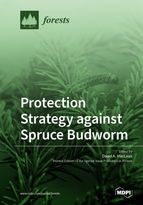Protection Strategy against Spruce Budworm
A special issue of Forests (ISSN 1999-4907). This special issue belongs to the section "Forest Ecology and Management".
Deadline for manuscript submissions: closed (31 July 2019) | Viewed by 46450
Special Issue Editor
Interests: forest ecology; early intervention against spruce budworm; forest management and biodiversity; stand dynamics and modeling; insect impacts on forests
Special Issue Information
Dear Colleagues,
Spruce budworm (Choristoneura fumiferana (Clem.)) outbreaks are a dominant natural disturbance in forests of Canada and northeastern USA. Widespread, severe defoliation by this native insect results in large-scale mortality and growth reductions of spruce (Picea sp.) and balsam fir (Abies balsamea (L.) Mill.) forests, and largely determines future age-class structure and productivity. The last major spruce budworm outbreak defoliated over 58 million hectares in the 1970s–1980s, and caused 32–43 million m3/year of timber volume losses from 1978 to 1987, in Canada.
Management to deal with spruce budworm outbreaks has emphasized forest protection, spraying registered insecticides to prevent defoliation and keep trees alive. Other tactics can include salvage harvesting, altering harvest schedules to remove the most susceptible stands, or reducing future susceptibility by planting or thinning. Chemical insecticides are no longer used, and protection strategies use the biological insecticides Bacillus thuringiensis (B.t.) or tebufenozide, a specific insect growth regulator. Over the last four years, a $20 million research project has tested another possible management tactic, termed an early intervention strategy, aimed at area-wide management of spruce budworm populations. This includes intensive monitoring to detect ‘hot spots’ of rising budworm populations before defoliation occurs, targeted insecticide treatment to prevent spread, and detailed research into target and non-target insect effects.
The objective of this Special Issue is to compile the most recent research on protection strategies against spruce budworm. A series of papers will describe results and prospects for use of an early intervention strategy in spruce budworm and other insect management.
Dr. David MacLean
Guest Editor
Manuscript Submission Information
Manuscripts should be submitted online at www.mdpi.com by registering and logging in to this website. Once you are registered, click here to go to the submission form. Manuscripts can be submitted until the deadline. All submissions that pass pre-check are peer-reviewed. Accepted papers will be published continuously in the journal (as soon as accepted) and will be listed together on the special issue website. Research articles, review articles as well as short communications are invited. For planned papers, a title and short abstract (about 100 words) can be sent to the Editorial Office for announcement on this website.
Submitted manuscripts should not have been published previously, nor be under consideration for publication elsewhere (except conference proceedings papers). All manuscripts are thoroughly refereed through a single-blind peer-review process. A guide for authors and other relevant information for submission of manuscripts is available on the Instructions for Authors page. Forests is an international peer-reviewed open access monthly journal published by MDPI.
Please visit the Instructions for Authors page before submitting a manuscript. The Article Processing Charge (APC) for publication in this open access journal is 2600 CHF (Swiss Francs). Submitted papers should be well formatted and use good English. Authors may use MDPI's English editing service prior to publication or during author revisions.
Keywords
- spruce budworm
- forest protection
- early intervention strategy
- decision-support system
- area-wide insect population management
- block planning
- timber supply effects
- economic effects
- monitoring and detection
- targeted insecticide treatment






